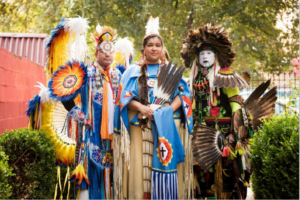April 5, 2022
Maryland: Indigenous Land Acknowledgement

From left: E. Keith Colston (Tuscarora/Lumbee), Celest Swann (Powhatan) and Louis Campbell (Lumbee) appear in support of the Baltimore American Indian Center, the recipient of MSAC’s 2017 Heritage Award in the category of place. Photo by Edwin Remsberg Photographs, courtesy Maryland State Arts Council and Edwin Remsberg Photographs
The Maryland State Arts Council (MSAC) consulted with tribal leaders and the administrator of the Maryland Commission on Indian Affairs for the MSAC Land Acknowledgement Project, which was administered by Maryland Traditions, MSAC’s traditional arts program. The project provides resources for acknowledgements of indigenous lands claimed by the State of Maryland and shares recommendations for how to move beyond these statements toward positive change led by tribal peoples. At its core, this work was done to ensure that the land acknowledgements MSAC created were more than mere words. This collaboration offers independent artists and arts and culture organizations in Maryland the tools needed to better understand and support Indigenous peoples. Native voices were centered throughout the two-year process; project consultants included current and former tribal chiefs, tribal chairs, tribal speakers and numerous tradition bearers, who were compensated for their labor.
The project culminated in a set of public resources, including a Land Acknowledgement Project Overview and Resource Guide. The guide provides a summary of the land acknowledgement project and its key goals: undoing Indigenous erasure, fostering deeper relationships between tribal people and MSAC, and creating public resources for arts and culture practitioners. It offers culturally specific information, recommends additional resources and highlights action steps for furthering equity.
The resource guide also contains the nine land acknowledgements that MSAC created: one for each of the eight individual tribes with which MSAC consulted on the project and one generalized, statewide acknowledgement. Each section contains background history on the tribe, a pronunciation guide and a map of tribal lands.
Additionally, during the two years in which MSAC was working toward developing its land acknowledgement, it produced two workshops, one giving context to land acknowledgments and one featuring recommendations from tribal leaders and elders on meaningful change. A Still Here social media campaign was conducted to highlight the contemporary creative works of Indigenous artists. For more information about the project, contact MSAC Folklife Specialist Ryan Koons. You can read about other equitable actions MSAC is undertaking in NASAA’s In Pursuit of Equity: Four Case Studies of State Arts Agencies.
In this Issue
From the President and CEO
State to State
Legislative Update
The Research Digest
Announcements and Resources
More Notes from NASAA
SubscribeSubscribe
×
To receive information regarding updates to our newslettter. Please fill out the form below.

